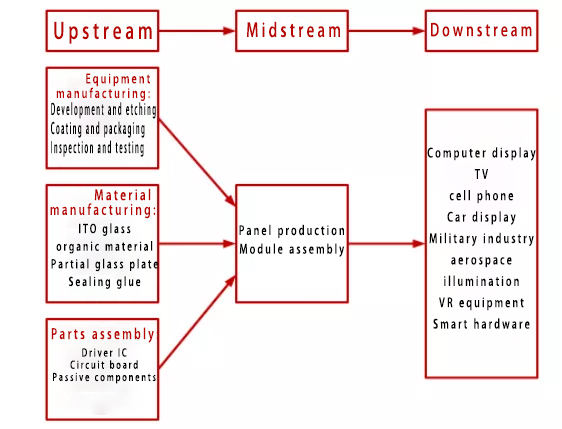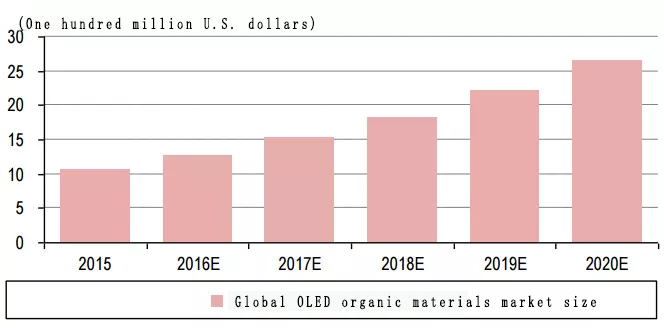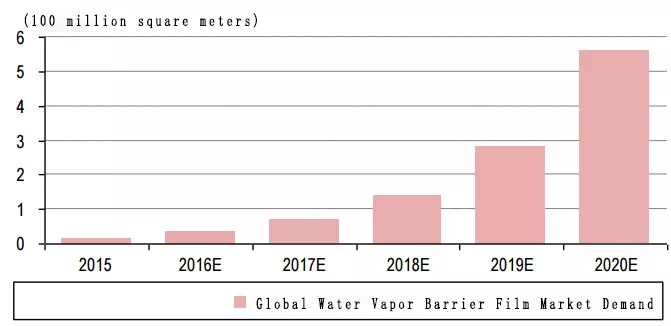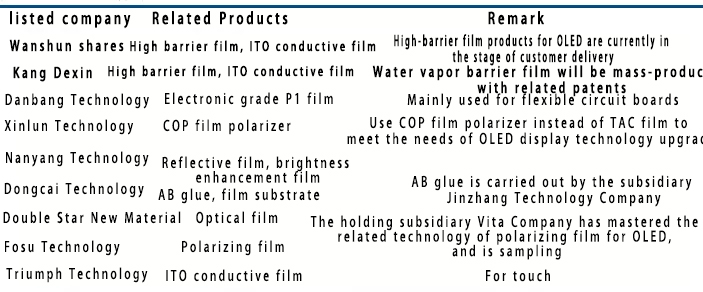In 2017, China's flat panel display has become the world's first, accounting for more than 22% of the global market, with an industry scale of more than 300 billion yuan.
In recent years, OLED has become the focus of industry attention, especially the use of OLED screens in iPhone x smart phones will further promote the industrial application of OLED technology. This article will give a brief description of the materials in OLEDs.

▲OLED Industry Chain

▲OLED core process flow

▲OLED transmission layer, light-emitting layer supply chain
OLED core materials mainly include anode, cathode, transport layer materials and light-emitting layer materials, as well as film materials and packaging materials.
Anode material
The anode material of OLED is mainly used as the anode of the device, and its work function is required to be as high as possible in order to improve the efficiency of hole injection. At the same time, OLED devices require that one side of the electrode must be transparent. Therefore, Au, transparent and conductive are generally used. Polymer (such as polyaniline) and ITO conductive glass, ITO glass is commonly used.
Cathode material
The cathode material of OLED is mainly used as the cathode of the device. The lower the metal work function of the cathode material, the easier the injection of electrons, the higher the luminous efficiency, the less Joule heat generated during operation, and the longer the life of the device. The improvement.
The cathode of OLED usually adopts the following types:
Single-layer metal cathode. Such as Ag, Al, Li, Mg, Ca, In, etc., but they are easily oxidized in the air, resulting in unstable devices and shortened service life.
Alloy cathode. For example, Mg:Ag (10:1), Li:Al (0.6%Li) alloy electrodes, the active low work function metal and the chemically stable high work function metal are evaporated together to form a metal cathode, which improves the quantum efficiency of the device. stability.
Layered cathode. Add a barrier layer between the light-emitting layer and the metal electrode, such as LiF, CsF, RbF, etc., which form a double electrode with Al, which can obtain higher luminous efficiency and better I-V characteristic curve.
Doped composite electrode. Sandwiching an organic layer doped with a low work function metal between the cathode and the organic light-emitting layer can greatly improve the device performance, such as ITO/NPD/AlQ/AlQ(Li)/Al.
Transmission layer material
OLED devices require that the injection rate of holes and electrons into the light-emitting layer should be basically the same, so it is necessary to select appropriate hole and electron transport materials.
In the working process of the device, heat may cause the transmission material to crystallize and cause the performance of the OLED device to degrade. Therefore, a material with a higher glass transition temperature should be selected as the transmission material. In the experiment, NPB is usually used as the hole transport layer, and Alq3 is used as the electron transport material.

▲OLED materials of each layer
Membrane material
Polarizers are key materials in LCD and AMOLED panels. Traditional polarizers are mainly composed of various compensation films such as TAC and PVA.
Due to changes in the structure of AMOLED polarizers, the number of TAC films used has decreased, and COP films with better mechanical properties, temperature resistance and weather resistance have been used.
Packaging materials
Thin-film encapsulation is currently the mainstream technology of encapsulation. Thin-film packaging materials are mainly divided into inorganic packaging materials, organic packaging materials and inorganic-organic composite packaging materials. Inorganic-organic composite packaging materials have the advantages of good water and oxygen barrier properties of inorganic packaging materials and good film forming properties of organic packaging materials. It is OLED The mainstream choice of packaging materials.
OLED material market space:
Most OLED materials cannot be used in common with LCD, so the market opportunities in the field of OLED upstream materials are greater.
The field of OLED materials has high technical barriers, low market competition, and high gross profit margins. It accounts for about 30% of the total cost of OLED products, and the future has broad space.
The parts of OLED upstream materials that cannot be used in common with LCD can be divided into organic materials and auxiliary materials. The auxiliary materials mainly include OLED film materials and OLED packaging materials. The growth of OLED panel shipments will strongly drive organic materials, film materials, and packaging materials. Demand growth.
(1) Organic materials: Organic materials account for about 8% of the total cost of OLED products.

▲Global OLED organic materials market size
(2) Film materials and packaging materials: LCD has two layers of polarizers, usually TAC film; while OLED has only one layer of polarizer, due to changes in the structure of the polarizer, the number of TAC films used in OLEDs is reduced, and the new film material COP The film is applied, and the COP film accounts for about 5%-7% of the cost of OLED products.
When OLED is working, in order to prevent water vapor from entering and chemically reacting with the cathode and the transmission layer, encapsulation materials are required. Usually, a water vapor barrier film with high barrier properties to water and oxygen is used.

▲The global water vapor barrier film market demand area is growing rapidly
OLED upstream material organic material manufacturing process:
In the production process of OLED upstream materials, firstly, chemical raw materials are used to synthesize OLED intermediates, and then the intermediates are further synthesized into crude monomers. The crude monomers are sublimated by OLED terminal material manufacturers to become OLED monomers, which are further used in OLEDs. Panel production.

▲OLED upstream material manufacturing process
OLED terminal material production and organic material technology are in the hands of foreign companies. At present, OLED terminal manufacturers are mainly Korean, Japanese, German and American manufacturers, including South Korean Samsung SDI, LG Chem, Tokuyama Metals, Doosan, Idemitsu Kosan, Fort Doya Chemical, UDC, and Merck.
The main threshold restricting new entrants is the patents of sublimation materials. Most of the current mainstream organic material technologies are owned by foreign companies, and foreign companies have patented these technologies.

▲Major supplier of OLED key raw materials
Domestic companies are mainly engaged in the production of OLED intermediates and crude monomers. Domestic suppliers of OLED intermediates and crude monomers mainly include Wanrun, Xi'an Ruilian, Puyang Huicheng, Beijing Agraya, and Jilin Aolaide. Among them, Wanrun, Puyang Huicheng, Xi'an Ruilian, etc. Has achieved large-scale mass production and entered the global OLED material supply chain.
The main industry barrier for OLED intermediates and crude monomers is the recognition of downstream manufacturers. These companies that have entered the OLED supply chain will benefit from the rapid growth in OLED demand.

▲Major domestic manufacturers of OLED intermediates and crude monomers
OLED film materials and packaging materials domestic companies follow up


▲Listed companies related to OLED display films
For OLEDs, due to changes in the structure of the polarizer, the number of TAC films used in OLEDs has decreased, and COP films with better mechanical properties, temperature resistance and weather resistance have been used.
There are three main types of thin film packaging materials: inorganic packaging materials, organic packaging materials and inorganic-organic composite packaging materials.
Inorganic-organic composite packaging materials combine the advantages of inorganic packaging materials with good water vapor and oxygen barrier properties and the advantages of organic packaging materials with good film-forming properties, and are the mainstream direction of OLED packaging materials.
At present, Samsung and LG are at the forefront of industrialization based on their leading positions in OLED panels, and their thin-film packaging technology is even more advanced.
Since OLED organic materials are sensitive to water and oxygen, and are prone to react and fail when exposed to water or oxygen, OLED packaging materials need to have good barrier properties, especially the barrier properties of substrates and packaging covers.
At present, the water and oxygen barrier of the substrate and the cover plate can be achieved by depositing a multilayer inorganic film with a stacked structure on the surface of the flexible substrate, or by pasting a barrier film.
Barrier films are generally based on plastics, on which inorganic oxides are deposited on the substrate by magnetron sputtering, electron beam evaporation, or plasma enhanced chemical vapor deposition to form water vapor barrier films. Compared with LCD displays, flexible barrier films or barrier materials are pure increments and benefit the most.
The 8 inch displays might be affected and delay for an accident.
This is the project management of how sinocrystal handle your customized project relate to displays.
New iPhone 13 Series will use On-Cell OLED Displays. And it that will be launched in the second half of this year will be exclusively supplied by Samsung Display (SDC)
A complete guide to LCD display connection methods, including SPI, I2C, RGB, MIPI, LVDS interfaces and physical mounting options. Learn how to connect monochrome and TFT LCDs to your development board or product housing.
This week, we had the pleasure of hosting an esteemed international client at our LCD display manufacturing facility in Dongguan. Guided by our team, the client visited key production areas such as the fully automated COG bonding line, backlight assembly area, full lamination workshop, and final product aging test section. They highly appreciated our production capacity, strict quality control, and engineering expertise. This visit strengthened mutual trust and set the stage for future collabora
The ILI9881C is a high-performance a-Si TFT LCD single-chip driver developed by ILI Technology Corp. With its excellent display performance and flexible configuration options, this driver meets the modern display device requirements for high resolution and color accuracy. This article will detail the supported resolutions, interfaces, and power supply voltage of the ILI9881C.
The GC9307, a TFT LCD driver with QVGA resolution, has gained widespread use among LCD module manufacturers since its launch. Sinocrystal are excited to share a series of practical insights we have gathered from using the GC9307 driver.